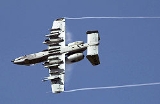
Hardpoint
Encyclopedia
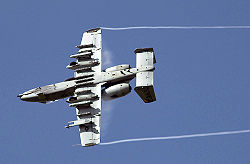
Airframe
The airframe of an aircraft is its mechanical structure. It is typically considered to include fuselage, wings and undercarriage and exclude the propulsion system...
designed to carry an external load. This includes a point on the wing
Wing
A wing is an appendage with a surface that produces lift for flight or propulsion through the atmosphere, or through another gaseous or liquid fluid...
or fuselage
Fuselage
The fuselage is an aircraft's main body section that holds crew and passengers or cargo. In single-engine aircraft it will usually contain an engine, although in some amphibious aircraft the single engine is mounted on a pylon attached to the fuselage which in turn is used as a floating hull...
of military aircraft
Military aircraft
A military aircraft is any fixed-wing or rotary-wing aircraft that is operated by a legal or insurrectionary armed service of any type. Military aircraft can be either combat or non-combat:...
where external ordnance
Aircraft ordnance
Aircraft ordnance or ordnance is weapons used by aircraft. The term is often used when describing the weight of air-to-ground weaponry that can be carried by an aircraft or the weight that has been dropped...
, countermeasure
Countermeasure
A countermeasure is a measure or action taken to counter or offset another one. As a general concept it implies precision, and is any technological or tactical solution or system designed to prevent an undesirable outcome in the process...
s, gun pod
Gun pod
A gun pod is a detachable pod or pack containing machine guns or automatic cannon and ancillaries, mounted externally on a vehicle such as a military aircraft which may or may not also have its own guns....
s, targeting pods or drop tank
Drop tank
In aeronautics, a drop tank is used to describe auxiliary fuel tanks externally carried by aircraft. A drop tank is expendable and often jettisonable...
s can be mounted.
Rail launchers

F-4 Phantom II
The McDonnell Douglas F-4 Phantom II is a tandem two-seat, twin-engined, all-weather, long-range supersonic jet interceptor fighter/fighter-bomber originally developed for the United States Navy by McDonnell Aircraft. It first entered service in 1960 with the U.S. Navy. Proving highly adaptable,...
, the F-18, and the Panavia Tornado ADV
Panavia Tornado ADV
The Panavia Tornado Air Defence Variant is a long-range, twin-engine interceptor version of the swing-wing Panavia Tornado. The aircraft's first flight was on 27 October 1979, and it entered service in 1986. It was retired on 22 March 2011 by the Royal Air Forceand is now only in service with the...
that have missiles that are semi-recessed into the fuselage to reduce drag, and hence use ejector launchers that first propel the missile clear of the aircraft before igniting the motor.
Ejector racks
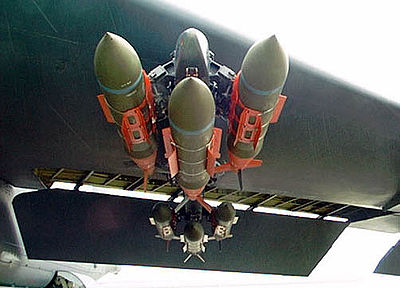
The mechanical interface between the rack and various stores is standardized so that a single type of rack can carry different stores. With the aid of a multiple-ejector rack, an aircraft may carry several weapons on one hardpoint, subject to various considerations of clearance, weight, drag, radar signature, and technological limitations.
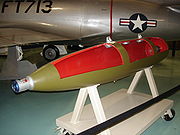
Wet hardpoints
Wet hardpoints refers to hardpoints which are plumbed and thus capable of interfacing with drop tankDrop tank
In aeronautics, a drop tank is used to describe auxiliary fuel tanks externally carried by aircraft. A drop tank is expendable and often jettisonable...
s mounted on it, to feed fuel from these external fuel tanks and provide additional fuel capacity for the aircraft. This extends the aircraft's flight range and duration for extended operations. These drop tanks can then be jettisoned if there is a need to reduce drag or weight during the flight. While wet hardpoints are capable of using drop tanks, they may also mount weapons as with other 'dry' hardpoints. In particular, the Matra JL-100 represents this as a pod that contains a drop tank in the rear and a rocket pack in the front.
Swing-wing aircraft
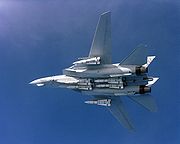
Swing-wing
A variable-sweep wing is an aeroplane wing that may be swept back and then returned to its original position during flight. It allows the aircraft's planform to be modified in flight, and is therefore an example of a variable-geometry aircraft....
s must swivel to minimize drag, such as on the General Dynamics F-111
General Dynamics F-111
The General Dynamics F-111 "Aardvark" was a medium-range interdictor and tactical strike aircraft that also filled the roles of strategic bomber, reconnaissance, and electronic warfare in its various versions. Developed in the 1960s by General Dynamics, it first entered service in 1967 with the...
and the Panavia Tornado
Panavia Tornado
The Panavia Tornado is a family of twin-engine, variable-sweep wing combat aircraft, which was jointly developed and manufactured by the United Kingdom, West Germany and Italy...
. Alternatively, the hardpoints can be placed on a rigid part of the aircraft, such under the fuselage or on fixed wing gloves as on the F-14 Tomcat
F-14 Tomcat
The Grumman F-14 Tomcat is a supersonic, twin-engine, two-seat, variable-sweep wing fighter aircraft. The Tomcat was developed for the United States Navy's Naval Fighter Experimental program following the collapse of the F-111B project...
and Mikoyan MiG-27
Mikoyan MiG-27
The Mikoyan MiG-27 is a variable-geometry ground-attack aircraft, originally built by the Mikoyan design bureau in the Soviet Union and later license-produced in India by Hindustan Aeronautics as the Bahadur . It is based on the Mikoyan-Gurevich MiG-23 fighter aircraft, but optimized for...
. On the F-111 not all hardpoints can be used if the plane is to operate with fully swept wings because of the narrowed spacing between pylons.
Designation
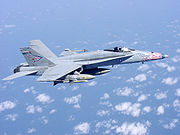
Boeing
The Boeing Company is an American multinational aerospace and defense corporation, founded in 1916 by William E. Boeing in Seattle, Washington. Boeing has expanded over the years, merging with McDonnell Douglas in 1997. Boeing Corporate headquarters has been in Chicago, Illinois since 2001...
F/A-18A/B/C/D family has nine weapons stations:
- 1 & 9, at the wingtips, have a single rail launcher for an AIM-9 type store.
- 2, 3, 7, & 8, located under the left and right wings, have mounting points for SUU-63A or SUU-63A/A pylons. The pylons in turn support a BRU-32/A ejector rack, to which various stores or launchers are attached. These stations may have a bomb loaded directly upon them, or have a multiple-ejector rack with several stores, or various rail-type launchers for air-to-air and air-to-ground missiles:
- A LAU-115 rail-type launcher for an AIM-7;http://www.ordnance.org/lau115.htm
- A LAU-115 with two LAU-7 or LAU-127 launchers, one bolted to either side, for two AIM-9 or AIM-120s;http://www.ordnance.org/lau127.htm
- A LAU-117 for an AGM-65 Maverick;http://www.fas.org/man/dod-101/sys/ac/equip/lau-117.htm
- A LAU-118 for an AGM-88 HARM http://www.fas.org/man/dod-101/sys/ac/equip/lau-118.htm
- 4 & 6, which are located on the sides of the fuselage, are LAU-116 ejector-type launchers for AIM-7 and AIM-120 missiles. Station 4 can also support a Forward-Looking Infrared (FLIR) pod for detecting and marking targets.
- 5, which is on the centerline underneath the fuselage, mounts a smaller SUU-62/A pylon and a BRU-32 rack, and many of the same stores as the wing pylons. The exception is anything rocket-powered, to avoid endangering the nose landing gear.
- 3, 5, & 7, are 'wet' feed fuel to and from external fuel tanks.

